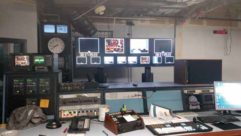It’s time for our periodic update on spectrum — that invisible resource that pro audio counts on for wireless transmission, mobile companies covet for new services, and the government continues to auction off. For now, it looks like spectrum reallocation won’t be as disruptive as first thought — maybe.
The Federal Communications Commission’s spectrum auction is in its home stretch, though it will likely take into early 2017 to find out how much and what kind of RF spectrum will be left available for professional wireless microphone users like event producers, broadcasters and large houses of worship.
Although 126 MHz of television bandwidth below the 698 MHz range was made available for bid by companies such as Verizon, AT&T and Comcast, the second round now decreases it to 114 MHz, so the spectrum put up by broadcasters will leave frequencies at and below 578 MHz available for professional wireless microphone use. That means that as much as half of the wireless systems in use today could remain legally operational. For instance, the microphones in Sennheiser’s A-range product line, which are tunable between 516 and 558 MHz, will remain viable for users. They’re being joined by the company’s new A1-range products, which can be tuned even lower, between 470 and 516 MHz.
“That’s still well within UHF, a range that exhibits highly favorable wave propagation characteristics,” says Joe Ciaudelli, Sennheiser’s spectrum guru. “It’s still safe to invest in systems that do not tune above 578 MHz.”
Ciaudelli says things will become even clearer once the forward auction moves into subsequent phases, after initial, more speculative bids by broadcasters get a dose of reality through what is essentially a market-based approach to spectrum reallocation.
“Now it’s up to the wireless [broadband] industry to demonstrate the demand is there for low-band TV spectrum,” National Association of Broadcasters spokesman Dennis Wharton said in a statement this summer.
Meanwhile, wireless system providers are looking to manage customers’ expectations. Michael Mason, President of CP Communications, which supplies RF-based mobile products, frequency coordination and wireless audio communications for live events, says he’s been advising clients that it’s now okay to start buying wireless audio systems again, but to “buy low” — that is, systems that operate below 570 MHz, and only if necessary to replace systems whose useful lifespans would be ending anyway.
“Maintain the level of inventory you need to operate and have backup — there’s enough certainty about the lower end of the UHF spectrum now to do that comfortably,” he says. “But there will be new technologies and products that will more efficiently use higher-band spectrum in the future, between 941 and 960 MHz, in the 1.4-GHz range, and in the 6- to 7-GHz range.”
Karl Winkler, Vice President of Sales at wireless systems maker Lectrosonics, whose products are used extensively in touring, theatrical, and house-of-worship applications, says initial anxiety over spectrum loss — this time — may have been overblown. “The process is going to take longer than had been thought, but we’re not going to lose as much as we thought initially,” he says.
Read the full report at infocomm.org/rfspectrum









